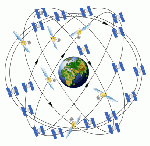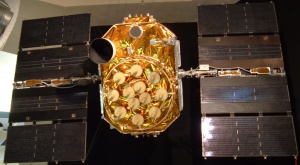If you wish to contribute or participate in the discussions about articles you are invited to contact the Editor
GPS Space Segment
| GPS | |
|---|---|
| Title | GPS Space Segment |
| Edited by | GMV |
| Level | Basic |
| Year of Publication | 2011 |
The main functions of the Space Segment are to transmit radio-navigation signals, and to store and retransmit the navigation message sent by the Control Segment. These transmissions are controlled by highly stable atomic clocks on board the satellites. [1]
The GPS Space Segment is formed by a satellite constellation with enough satellites to ensure that the users will have, at least, 4 simultaneous satellites in view from any point at the Earth surface at any time.
GPS Satellite Constellation
The nominal GPS satellite constellation consists of 24 space vehicles (SVs) distributed in six orbital planes with an inclination of 55 degrees in relation to the equator.
Orbits are nearly circular, with eccentricity less than 0.02, a semi-major axis of 26 560 km, i.e. an altitude of 20 200 km. Orbits in this height are referred to as MEO – medium earth orbit. The satellites have a speed of 3.9 km per second and a nominal period of 12 h sidereal time (11 h 58m 2 s), repeating the geometry each sidereal day. GPS SVs are arranged on 6 planes, each of them containing at least 4 slots. There is a spare satellite slot in each orbital plane, being the system capable of supporting a constellation of up to 30 satellites on orbit. The present configuration allows users to have a simultaneous observation of at least 4 satellites in view worldwide, with an elevation masking angle of 15 deg[1]. The space segment is subject to maintenance and evolutions.
GPS Satellite Description
The design of GPS satellites has evolved with time. Each generation of satellites with similar characteristics is called a block. A brief description of the different GPS blocks follows:[1]
- Block I, Navigation Development Satellites: Eleven satellites of this kind were launched between 1978 and 1985.[2] The Selective Availability (S/A) was not implemented. They weighed about 845Kg and had a planned average life of 4.5 years, although some of them lasted up to 10. They were capable of giving positioning service for 3 or 4 days without any contact with the control centre.
- Block II and IIA, Operational Satellites: They consist of 28 satellites in total that were launched from 1989 on and many are still operating.[3] They weigh about 1 500 Kg and have a planned average life of 7.5 years. Since 1990, an improved version was used, Block IIA (advanced), with capability of mutual communication. They are able to supply positioning service for 180 days with no contact with the control segment. However, under normal operating mode, they communicate daily.
- Block IIR, Replacement Operational Satellites:[3] From 1997, these satellites are being used as spares for Block II. Block IIR is formed by a set of 20 satellites, although it could be increased by 6 more. They weigh about 2 000Kg and have a planned average lifespan of 10 years. These satellites can determine their orbits and compute their own navigation message autonomously. They have the capability to measure distances between themselves and transmit data to other satellites or to the control segment. A block IIR satellite must be capable of operating about half a year without any support from Control Segment without degradation in ephemeris accuracy. It is expected that some of them could be equipped with Hydrogen masers.
- Block IIR-M, Modernized Satellites: They include a new military signal and the more robust civil signal L2C. There will be eight satellites in the Block IIR-M series. The first satellite of this block was launched on September 26, 2005 [3].
- Block IIF, Follow-on Operational Satellites: The first satellite (SVN62) was launched on May 28th 2010 [3][4]. These satellites include the third civil signal on the L5 band. Their theoretical average life is about 12 years, and they will have inertial navigation systems.
- Block III: The new generation of GPS satellites introduces significant enhancements in navigation capabilities, by improving interoperability and jam resistance. They provide the fourth civil signal on L1 band (L1C). The first launch is expected as of 2017[5].
Finally, the following table gathers the main characteristics of a GPS Satellite:[6]
| Block II/IIA | Block IIR | Blork IIR-M | Block IIF | |
|---|---|---|---|---|
| Primary Contractors | Rockwell International (Boeing North American) | Lockheed Martin | Lockheed Martin | Boeing North American |
| Solar Power Plant | 800 watts | 800 watts | 800 watts | 2450 watts |
| Weight | 1,816 kg | 2,217 kg | 2,217 kg | 1,705 kg |
| Height | 3.4 meters | 1.7 meters | 1.7 meters | 2.4 meters |
| Width | 5.3 meters | 11.4 meters | 11.4 meters | 35.5 meters |
| Design Life | 7.5 years | 10 years | 10 years | 12 years |
References
- ^ a b c J. Sanz Subirana, JM. Juan Zornoza and M. Hernández-Pajares, Global Navigation Satellite Systems: Volume I: Fundamentals and Algorithms
- ^ Block I Satellite Information
- ^ a b c d Block II Satellite Information
- ^ GPS Constellation Status
- ^ First GPS III Launch Slips to FY17, Inside GNSS, November 14, 2014
- ^ Global Positioning System Fact sheets


